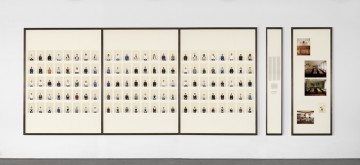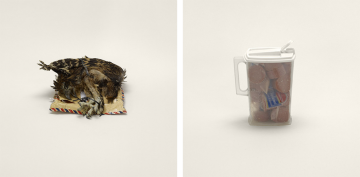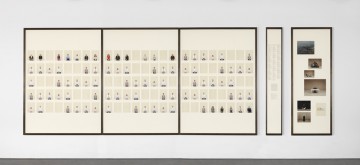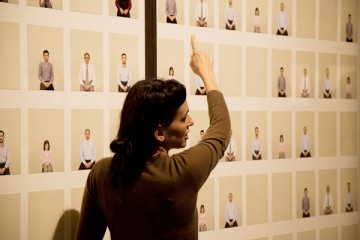
Taryn Simon. "Chapter VII, A Living Man Declared Dead and Other Chapters," 2008-2011. © Taryn Simon.
Taryn Simon‘s solo-exhibition, A Living Man Declared Dead and Other Chapters (2008-2011) at the Neue Nationalgalerie in Berlin is an imposing and exhaustive investigation of eighteen diverse bloodlines and their related stories. On the surface, each chapter presents a group of stark, straightforward portraits in a seemingly confusing yet linear framework, based mostly on the bloodlines of those included (or not, for various reasons) in the Chapters, as they are called (I – XVIII).
Visually, A Living Man Declared Dead is a departure from other recent works like An American Index of the Hidden and Unfamiliar, 2007, in which Simon assumed the “the dual role of shrewd informant and collector of curiosities, compiling an inventory of what lies hidden and out-of-view within the borders of the United States,” by presenting numerous, exquisite photographs of locations or items that are generally considered off-limits, or Contraband, 2009, where Simon, who described the project as both a “performance” and “exercise in exhaustion” spent five days and nights at the U.S. Customs and Border Protection Federal Inspection Site and the U.S. Postal Service International Mail Facility at John F. Kennedy International Airport in New York, systematically arranging and photographing each item seized from passengers or mail entering the U.S. from abroad. The 1,075 resulting photographs comprise a visual encyclopedia of what cannot enter the United States.

Taryn Simon. "Bird corpse, labeled as home décor, Indonesia to Miami, Florida (prohibited); Plastic pitcher of salami, Eastern Europe (9CFR.94) (prohibited)," from the series "Contraband," 2009.
Both An American Index and Contraband inherently contain a bit of humor within their vast scopes, whether they are art-funny (a blandly-lit hallway with two Thomas Downing paintings hung in a hallway of the CIA headquarters); somewhat sophomoric (a Playboy magazine for the blind) or just ludicrous (a plastic pitcher stuffed with large chunks of salami, or a dead hawk in an envelope labeled as “home décor.” A Living Man Declared Dead is decidedly more somber, showing us the often-ignored injustices, whether they be genetically-, chemically-, politically-, or ancestrally-induced; albinos in Africa (Chapter XVI), exposure to Thalidomid (VIII), survivors of Serbian genocide (VII), or the plight of being a teenaged orphan in Ukraine (XVII). Most likely the hardest-to-follow bloodline, with its self-referencing stops and starts, should be that of the Btaddini family (XIV):
“Ribal Btaddini (17) is believed to be the reincarnation of his paternal grandfather, Milhem Btaddini (17). He is therefore both father and son to his own father, Fouad Btaddini (18), and the grandfather of his brothers, Feras Btaddini (19) and Iad Btaddini (21). As a child, Ribal was able to recall aspects of his previous life, including the location of his home and how to get there; clothing and where it had been purchased; bombings that had taken place the night of his death; and how his wife tried to drag his injured body to safety. Ribal belongs to the Druze, a religious community found primarily in Lebanon, Israel, Jordan, and Syria.”

Taryn Simon. "Chapter XIV, A Living Man Declared Dead and Other Chapters," 2008-2011. © Taryn Simon.
To label Simon solely as a photographer would be incorrect; simply, she is an artist who uses the medium of photography (and quite well, of course) to visualize and present the copious amounts of research and coordination that goes into each body of work. In A Living Man Declared Dead, the photographic element, while still clearly present, is stripped of nearly all aesthetic interplay or discussion, save the use of a very pale orange (or, “gamboge” according to this reference ) backdrop. At a walk-through the artist gave at the Museum on September 29th, she told the audience that this series was executed in a stripped-down, machine-like way, and in a way that needed to be reproducible though many iterations, under different conditions, in many different cities, many different countries. The tight controls and effort paid off; each photo seems to have been shot in the same studio on the same day.
Simon’s second medium, in this work and others, is text. For A Living Man Declared Dead, she strove for a seemingly unauthored, almost textbook-like set of captions. Simon speaks on how she purposefully makes the text diminished and off to the side, so that one cannot view both text and image at once, but a separate investigation of both halves of the work must be executed. Each Chapter’s accompanying texts lists the names and birthdates (a surprising number of which were listed as “unknown”) and the relationships of those pictured to each other. When someone was unable to sit for their portrait, an empty portrait was shot and placed in their stead, and their respective caption is greyed out, and often less informative. Simon doesn’t view these absences as detrimental to the work, with good reason; the empty portraits highlight the subject’s inability or unwillingness to sit, sometimes due to fear, mistrust or simply being unlocatable, despite the great deal of research on the part of the artist and her team (the artist’s sister is her main assistant) and the local ‘fixer’ that is hired in each location.

Installation view of Taryn Simon's "A Living Man Declared Dead and Other Chapters I - XVIII" at the Neue Nationalgalerie. Photo: David von Becker.
It seems worth noting that this show is concurrently on display at the Tate Modern, a feat not often possible with more traditional art mediums (painting, sculpture, etc). Both installations are quite varied, and enable viewers to have different interactions with the same body of work. The Tate installation is fairly straightforward, with large multi-panel frames hung directly on the wall, while at the Neue Nationalgalerie, each Chapter is ensconced in its own commode, for lack of a better word. Each freestanding, custom-built unit almost operates as a stand-alone gallery of sorts, each with two wings and somewhat of a ceiling as well, providing space and a welcome visual separation from the other 17 Chapters, each of which has a fairly overwhelming quality when viewed singularly, let alone as a group. This display situation is of course necessary because the upper level of the Neue Nationalgalerie, where the show is installed, has no walls to speak of, just pure Van der Rohe windows, floor to ceiling, surrounding the vast space of the gallery.

Taryn Simon speaking on her work "A Living Man Declared Dead" at the Neue Nationalgalerie as part of "Mono.klub #35: Taryn Simon." Photo: Kai von Rabenau.
Simon says of her work, “I try to keep a clear distance from the subject. I never want to say that I understand or somehow know the subject. In fact, it’s more that I don’t know.” Indeed, it’s apparent that Simon is offering no solution to the problems that some of these related groups face, and is merely outlining the beginning of the problems they all deal with; while sobering, the works that make up A Living Man Declared Dead don’t instill guilt on the part of the viewer, yet it may overwhelm their brains with so many tragic, multi-generational stories that they are soon numb.




